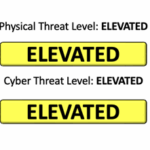
Faith-Based Daily Awareness Post 15 October 2025
Faith-Based Security Headlines
These updates are shared to help raise the situational awareness of Faith-Based organizations to best defend against and mitigate the impacts from all-hazards threats including physical security, cybersecurity, and natural disasters.
Beginning on Monday 20 October 2025, the DAP publishing schedule will permanently move to the afternoon to accommodate adjusting operational requirements. The DAP will still be published daily, with the exception of observed U.S. government holidays.
More U.S. Jews shield identity in public amid antisemitism fears, Post poll finds
A new Washington Post poll finds that many American Jews are increasingly cautious about displaying Jewish symbols publicly, citing concerns about antisemitism. Nearly 42% say they have avoided showing or wearing anything that may identify them as Jewish which is up 26% since 2023. Only 18% feel as if they feel “very safe” in the U.S. while a third say they don’t feel safe at all. The poll also reveals deep skepticism toward President Trump’s efforts to curb campus antisemitism: nearly two-thirds believe it is politically motivated rather than sincere, and 69% doubt the new DOJ task force will be effective. On campuses, Jewish Americans hold varied views about what counts as antisemitism: while most consider denial of Israel’s right to exists or blaming U.S. Jews for Israel’s actions as antisemitic fewer than 15% see all criticism of Israel as antisemitic.
Analyst Comments: The findings highlight growing unease and caution among U.S. Jewish communities, with many feelings less comfortable expressing visible aspects of their identity. This sentiment reflects a broader concern about social tension and online hostility, suggesting that fear of antisemitism is influencing everyday decisions about safety and public presence. The data also points to rising uncertainty about where reliable support can be found, emphasizing a need for stronger community-based safety initiatives, interfaith outreach, and education programs that address bias at its roots.
Get the Facts: How common is violence at churches, houses of worship?
The WCVB article examines the patterns of violence at U.S. HOWs; finding that while such attacks are rare, they are nonetheless a persistent concern. Over the last 25 years, about 380 incidents have resulted in around 490 deaths and 170 injuries at religious institutions nationwide, according to data from the Violence Prevention Project. Most of these events are not mass shootings; nearly 90 percent of fatal attacks since 2000 involved only a single victim. About 68 percent of killing incidents at HOWs were carried out using firearms, with the remainder involving knives, blunt instruments, or vehicles.
While Christian churches make up the vast majority (97%) of these fatal attacks, largely reflective of the greater number of Christian institutions in the U.S., synagogues, mosques, and other religious sites have also been targeted. The article emphasizes that many of these instance’s stem from interpersonal disputes, domestic violence, or opportunistic crime rather than ideologically motivated hate, though the deadliest attacks historically have often carried ideological motives.
Analyst Comments: The report illustrates how even infrequent acts of violence at HOWs have disproportionate emotional and social impact. The data suggests that while ideologically driven attacks often capture national attention, most incidents are rooted in personal or domestic conflicts underscoring the broader overlap between community-based violence and faith-based settings. The findings also point to the importance of situational awareness and preparedness training for religious organizations. Building partnerships with local law enforcement, improving crisis communication plans, and offering de-escalation training could help mitigate risk without undermining the inclusive e mission of these institutions.
Threat Level Orange: U.S. Cities With the Most Reported Terrorism
The 24/7 Wall Street report ranks U.S. cities by the number of reported terrorist incidents between 1970 and 2021, based on data from the START Global Terrorism Database. It finds that a small number of cities account for a disproportionate share of such attacks: the top 35 cities together represent nearly 49 percent of all incidents in the country. New York City leads by a wide margin, with 478 reported attacks and 2,831 fatalities over the period, followed by Los Angeles and San Franciso. The most common form of attacks has been bombings and infrastructure assaults, targeting a mix of public institutions, businesses, and symbolic locations such as diplomatic or religious sites. The article also notes a shift in the terrorism landscape: more recent threats increasingly stem from lone actors rather than large, organized networks, a trend that complicates detection and prevention efforts.
Analyst Comments: The 24/7 Wall Street report ranks U.S. cities by the number of reported terrorist incidents between 1970 and 2021, based on data from the START Global Terrorism Database. It finds that a small number of cities account for a disproportionate share of such attacks: the top 35 cities together represent nearly 49 percent of all incidents in the country. New York City leads by a wide margin, with 478 reported attacks and 2,831 fatalities over the period, followed by Los Angeles and San Francisco. The most common forms of attacks have been bombings and infrastructure assaults, targeting a mix of public institutions, businesses, and symbolic locations such as diplomatic or religious sites. The article also notes a shift in the terrorism landscape: more recent threats increasingly stem from lone actors rather than large, organized networks a trend that complicates detection and prevention efforts. The findings emphasize the continued need for localized threat awareness, interagency coordination, and community engagement to detect early signs of radicalization or targeted violence. The data also supports a risk-based approach to preparedness, prioritizing training, infrastructure protection, and public awareness in cities with higher historical exposure while maintaining vigilance nationwide.
More Faith-Based Stories
- Activists in Chicago, barred from giving Communion to ICE detainees, plan next actions
- TX: Fire marshal: San Angelo church fire may have been ‘intentionally set’
- Fire damages north St. Louis church, one firefighter injured
- Tracker: 500 Attacks on U.S. Catholic Churches Since May 2020; Last Updated October 15, 2025
- Church says pastor pointed gun at congregation to encourage ‘spiritual violence against unbelief’
- CP event tackles ethics of AI, urges Christians to be engaged: ‘We have to be the shapers’
- Turkey labels Christians ‘national security threat’ to deport them, rights group warns
- Second man arrested in connection to defacement of three Halifax synagogues, police announce
- Layoffs, reassignments further deplete CISA
- Top cyber lawmaker wants answers on CISA workforce reductions
- JPMorgan to Invest Up to $10 Billion in US Companies With Crucial Ties to National Security
- News organizations, including Hegseth’s former employer Fox, reject new Pentagon reporting rules
- What to know about Oct. 18 “No Kings” protests
- Map and List of ‘No Kings’ Protests Against Trump on October 18
- More than 1,500 people displaced after typhoon remnants devastate Alaskan villages
- Report proposes new framework to prepare for future pandemics
- US kills 6 people in strike on boat accused of carrying drugs near Venezuela, Trump says
- US rivalry pushing China to apply domestic law abroad, legal experts say
More Security-Focused Content

The FB-ISAO’s sponsor Gate 15 publishes a daily newsletter called the SUN. Curated from their open source intelligence collection process, the SUN informs leaders and analysts with the critical news of the day and provides a holistic look at the current global, all-hazards threat environment. Ahead of the daily news cycle, the SUN allows current situational awareness into the topics that will impact your organization.


